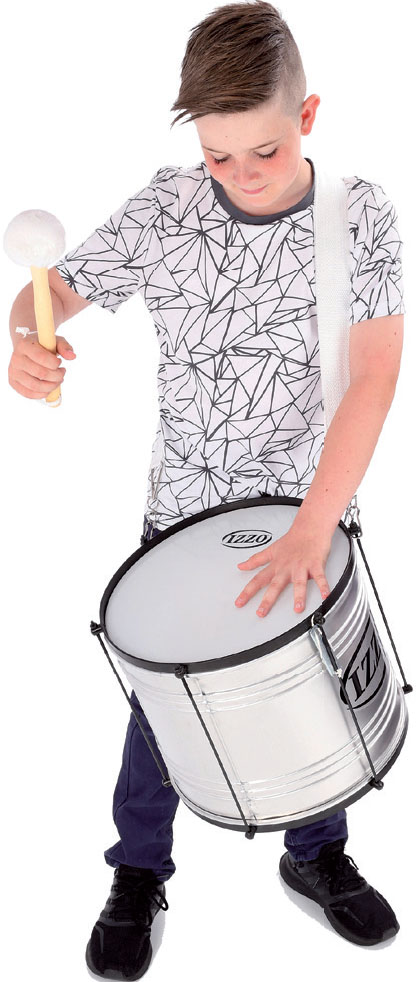
Founded more than 100 years ago in São Paulo, Izzo Brazil saw modest beginnings, finding life in a small building in the Plaza Marechal Deodoro da Fonseca. According to its website, the desire to produce musical instruments for a domestic market brought together three men who formed what would eventually become Izzo.
Since its establishment, Izzo has become a household name in percussion instruments, across Brazil and the rest of the world. It is a company that prides itself on the production and distribution of samba instruments, which includes cabasas and double agogo bells, as well as tambourines and marching drums.
Chamberlain Music Education is the exclusive importer and distributor of Izzo in the UK and Ireland. In modest conditions that almost mirror those of Izzo, Chamberlain Music was founded by John Hughes-Chamberlain in 1990, when he was aged just 23. Hughes-Chamberlain is now the managing director, and the company boasts an international customer base and is one of the largest music education suppliers in the UK. It is also part of Frederick Hyde Music Distribution – a company that also owns Percussion Plus, Musisca and Octopus Ukulele.
‘It was a small shop in Haslemere, but I founded it with the intention of supplying to schools and colleges,’ he tells me. It is in Haslemere where Chamberlain Music's huge warehouse can be found, and from there the company receives and ships orders. When we speak, he has just arrived back in the UK after a 10-day intensive factory tour in China – a testament to the reach of a company that found life in a small Surrey town nearly 30 years ago.
Returning to Izzo's development in the UK, Hughes-Chamberlain says: ‘Since the 1980s, when samba drums were first imported to this country, hundreds of school bands, extracurricular clubs and community schemes have been set up across the country – and they continue to grow in popularity among people of all ages and abilities.’
Samba, he tells me, was developed in Rio de Janeiro towards the end of the 19th century. ‘It fuses the historical traditions of West African slaves and Iberian conquerors with the heat and excitement of modern Brazil.’ It is also recognised around the world as the sound of Carnival.
‘There are many types of carnival in Brazil, but the main three are the Carnival de Avenida, the Carnival de Rua and the Carnival Axé,’ Hughes-Chamberlain says. ‘It's the main event of the year; Brazilians love it – it's a great opportunity to blow off some steam, have fun and enjoy a three-day party with drinks, music and dance.’
Carnival has since become synonymous around the world with celebration and colour. We hear the word ‘carnival’ and we see feathers, stoned bodices and streams of dancers banging drums, shaking cabasa and wielding agogos. No wonder, therefore, that schools are eager to replicate the joyous sounds of the celebration.
These days, it is of course much easier than it was in the 1980s to access musical instruments from cultures worlds away from what we're used to. With the Izzo instruments that Chamberlain Music distributes, how might a group of school-aged musicians use Carnival as a source of inspiration?
‘The surdo is the heart of the samba,’ Hughes-Chamberlain tells me. This is an aluminium drum that is available in many sizes. The set that Chamberlain Music distributes is comprised of authentic Brazilian instruments, manufactured by Izzo in São Paulo. They nest together like a Russian doll for ease of transport, with a black napa to offset the bright colours. ‘They deliver the bass frequency and dictate the pulse of the music. The diameter begins at 14 inches, but can go up to 24, and they are carried with a sling around the waist, which also comes in a range of sizes.’
There's also the hand-held tamborim, a beautiful, flat, lightweight drum which is traditionally hit with a double- or triple-pronged stick. ‘This has a sound derived from snare drums, with a nylon head that is tightly tuned to ensure a high, sharp timbre with minimum sustain,’ Hughes-Chamberlain says. ‘They are used across many genres of Brazilian music, but are most commonly associated with samba, pagoda and chorinho.’ With summer and an air of celebration now upon us, it feels like as apt a time as ever to explore the joys of Brazilian music. For teachers looking to explore samba instruments with their pupils, Chamberlain Music offers a great range of useful texts, from The Beatlife Book to Andy Gleadhill's Brazilian Samba Book, among others.

Playing a 16-inch Izzo surdo








